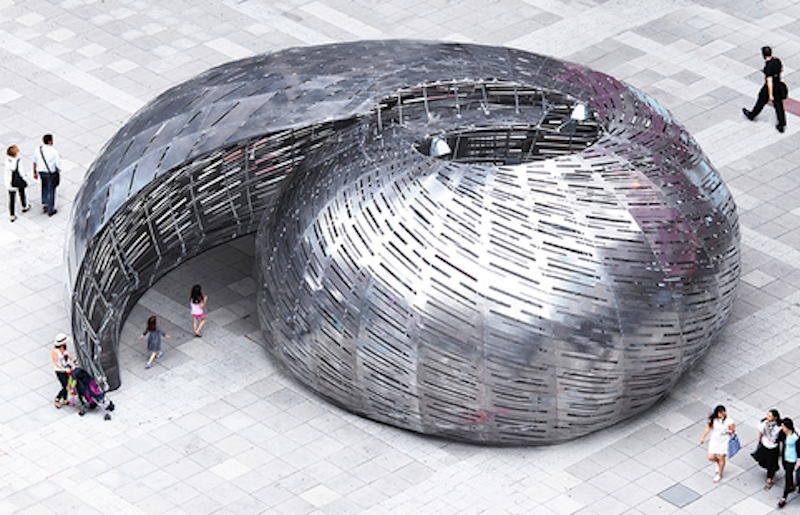NASA Orbit Pavilion, a new structure designed by StudioKCA in collaboration with the NASA Jet Propulsion Laboratory and sound artist Shane Myrbeck, looks to give visitors the experience of being surrounded by the sounds of satellites in space when it opens on Oct. 29 at The Huntington Library.
The idea behind the design of the structure was to mimic the experience of holding a seashell to one’s ear and hearing the ocean, but to do so on a much larger scale. Visitors won’t just hold this giant cosmic shell to their ears, they will walk inside of it and be met with “a symphony built out of the sounds of satellites in space,” according to Jason Kilmoski, Principal of StudioKCA.
Consisting of 28 speakers spatially arranged to mimic orbits, the pavilion acts as a sound chamber as satellites, represented by distinct, artistically created sounds, seem to swirl around visitors from above, below, and to all sides. There are 20 unique sounds in total, representing the International Space Station and 19 earth satellites.
The physical design of the structure also reflects the paths of space satellites. 100 orbital paths are cut via water jet into the 3,500 sf of aluminum panels that cover the aluminum framework of the pavilion. The design also minimizes external noise and decreases wind loads to make the experience for those within as immersive as possible.
The NASA Orbit Pavilion debuted in the summer of 2015 at the World Science Festival at New York University and will be on display at The Huntington Library until Feb. 27, 2017.
Click here to listen to the “symphony” of satellites.
Related Stories
| Nov 8, 2013
Oversized healthcare: How did we get here and how do we right-size?
Healthcare facilities, especially our nation's hospitals, have steadily become larger over the past couple of decades. The growth has occurred despite stabilization, and in some markets, a decline in inpatient utilization.
| Nov 8, 2013
Can Big Data help building owners slash op-ex budgets?
Real estate services giant Jones Lang LaSalle set out to answer these questions when it partnered with Pacific Controls to develop IntelliCommand, a 24/7 real-time remote monitoring and control service for its commercial real estate owner clients.
| Nov 8, 2013
S+T buildings embrace 'no excuses' approach to green labs
Some science-design experts once believed high levels of sustainability would be possible only for low-intensity labs in temperate zones. But recent projects prove otherwise.
| Nov 8, 2013
Net-zero bellwether demonstrates extreme green, multifamily style
The 10-unit zHome in Issaquah Highlands, Wash., is the nation’s first net-zero multifamily project, as certified this year by the International Living Future Institute.
| Nov 8, 2013
Walkable solar pavement debuts at George Washington University
George Washington University worked with supplier Onyx Solar to design and install 100 sf of walkable solar pavement at its Virginia Science and Technology Campus in Ashburn, Va.
| Nov 6, 2013
PECI tests New Buildings Institute’s plug load energy use metrics at HQ
Earlier this year, PECI used the NBI metrics to assess plug load energy use at PECI headquarters in downtown Portland, Ore. The study, which informed an energy-saving campaign, resulted in an 18 percent kWh reduction of PECI’s plug load.
| Nov 5, 2013
Net-zero movement gaining traction in U.S. schools market
As more net-zero energy schools come online, school officials are asking: Is NZE a more logical approach for school districts than holistic green buildings?
| Nov 5, 2013
New IECC provision tightens historic building exemption
The International Energy Conservation Code has been revised to eliminate what has been seen as a blanket exemption for historic buildings.
| Nov 5, 2013
Living Building Challenge clarifies net-zero definitions and standards
The Living Building Challenge has released the Net Zero Energy Building Certification to provide clearer definitions regarding what net zero really means and how it is to be achieved.
| Nov 5, 2013
Oakland University’s Human Health Building first LEED Platinum university building in Michigan [slideshow]
Built on the former site of a parking lot and an untended natural wetland, the 160,260-sf, five-story, terra cotta-clad building features some of the industry’s most innovative, energy-efficient building systems and advanced sustainable design features.

















